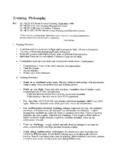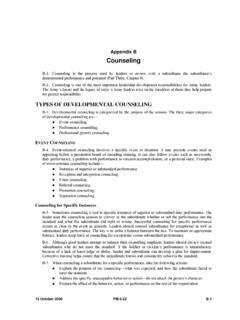Transcription of Exercise 7.1 What are advertising objectives?
1 These exercises look at the topics in the context of a communications mix .We start with an examination of what advertising objectives are ( Exercise ).We then look at how to set advertising objectives for one of your own product/market areas ( Exercise ), how to choose the most appropriate advertising media ( Exercise ) and how to build up an advertising plan ( Exercise ).Sales promotion is tackled in a slightly different way. The fi rst question that is asked is: Is a promotion necessary? ( Exercise ). If the answer to this question is affi rmative, then Exercise demonstrates how to plan a sales what are advertising objectives ?There are two basic questions that advertising objectives should address. Who are the people we are trying to infl uence? and what specifi c benefi ts or information are we trying to communicate to them? Research has shown that many companies set objectives for advertising which advertis-ing cannot possibly achieve on its own.
2 For example, to increase sales or to wipe out the competition . Equally, it is unrealistic to set an objective to convince the target market that our product is best , when any rational analysis would clearly show this not to be there is an element of confusion about what advertising objectives are and what marketing objectives are. Remember, marketing objectives are concerned with what prod-ucts go to which markets, whereas advertising objectives are measurable targets concerned principally with changing attitudes and creating is a list of marketing or other objectives and advertising objectives mixed up together. Read through this list and write against each objective:A if you believe it to be an advertising objective, orM if you believe it to be a marketing or other (M) or advertising (A) objectives ?* 1. To make attitudes more favourable to a particular product. 2. To build an image for the product. 3. To stop existing users turning to competitive products.
3 4. To get across the idea of a unique product. 5. To create a brand leader to help the launch of additional products at a future date. 6. To win back previous product users who have defected to a competitive product. 7. To expand the whole market. 8. To reduce existing negative attitudes.* Based on a list provided by Professor David Corkindale (formerly of Cranfi eld University School of Management) and used with his kind permission. 9. To keep building loyalty. 10. To establish the brand and position it in a particular way, as warm and friendly. 11. To create a brand leader in a particular market. 12. To increase sales among existing users. 13. To improve the frequency of purchase. 14. To keep new entrants out of the market. 15. To convey the idea that the product is value for money . 16. To say how much people like the product. 17. To improve market share compared with competitors. 18. To maintain brand answers to Exercise are as follows: advertising objectives : numbers 1, 2, 4, 8, 9, 10, 15 and or other objectives : numbers 3, 5, 6, 7, 11, 12, 13, 14, 17 and you made some mistakes in identifying the objectives correctly, go back and have another look at them and see if you can work out where you went Setting advertising objectivesBehind all effective advertising there lies a lot of careful thought and planning, and much of it goes into ensuring that the advertising objectives are the right ones.
4 If these are wrong, everything else which follows is doomed to this Exercise you are asked to concentrate on just one key market or market segment. It should be a relatively simple matter to repeat the process for other markets at some later a note somewhere about which market or segment you will be addressing. Remember, from the Boston Matrix or directional policy matrix, stars will probably be most deserving of the advertising make a note about the marketing objectives which have been set for this market/segment, what products? what quantities? to whom? etc. Having assembled this infor-mation, from the list of Possible advertising objectives below: 1. Select the most appropriate objectives , those that look the most promising to help the company achieve these marketing objectives (tick in the column). 2. From those you have ticked, eliminate any objectives that you believe can only be achieved by personal communication, by the sales force.
5 3. List your remaining objectives in rank order, the most important being at the top of the list. 4. Use only the top objective (and perhaps the second) as a basis for your advertising campaign.(Continued)Possible advertising objectivesIf you think this list omits possible advertising objectives for your company, then extend the list by adding your own objectives to Choosing the advertising mediaThe previous Exercise should have helped to identify the advertising objectives for your cho-sen market/segment. The next logical step would be to decide exactly what you want to communicate your creative , such a step does not really lend itself to an Exercise . Indeed, copywriting is such a specialized form of communication that most companies engage outside specialists to deal with it. Even so, having decided upon the advertising objectives , you must switch your focus of attention now to the target population you hope to infl uence:Who are they?
6 what positions do they hold? what is their infl uence on the purchasing decision? what personality traits do they exhibit? what socio-economic groupings do they belong to? what lifestyles do they have?How old are they? what sex are they? Are they married? And so on. Tick hereTick hereTo establish an immediate saleTo bring a prospect closer to a saleTo change customer perceptionsTo direct customer actionTo support the sales forceTo reinforce attitudes of existing customersTo open up distributionTo improve company imageTo demonstrate the product capabilitiesTo generate enquiriesTo impart informationTo reassure customersTo score points off competitors advertisingTo enter new marketsTo give reasons for buyingTo create awarenessTo support retailersTo convey the idea of value for money To reach new geographical areas To promote the idea of a unique productTo back up promotionsTo develop favourable attitudes to a particular productTo counter price competitionTo remind customers about our productTo reinforce the company imageTo defend market positionTo support the launch of a new product/serviceTo explain new uses for productTo emphasize range and choiceTo reinforce brand recognitionTo
7 Inform about product availabilityTo educate customersTo communicate company strengthsTo build customer loyaltyTo say how much people like the product Please note that it is usually easier to determine the most appropriate media in the case of business-to-business customers, although the same logic need to assemble as much information as you can about the target population. The more you know about them, the better your chances of selecting the best medium for your advertising accompanying worksheet gives a list of possible advertising media. Study this list and select what would be the best choice, taking into account your objectives and the profi le of the target making your choice, you will need to take four factors into account: 1. The character of the medium the geographical coverage it gives, the types of audi-ence it reaches, its frequency of publication or showing, its physical possibilities (such as colour, sound, movement), its power or potential to reach special groups, etc.
8 2. The atmosphere of the medium its ability to convey an image consistent with your objectives , hard and punchy, discreet, elegant, exclusive, etc. 3. The size of the medium the number of people exposed to the medium in terms of being aware of the contents. For example, a newspaper might be read by two or three members of a family, whereas a technical journal might be circulated to a large number of managers within a company. Alternatively, a poster might be passed by tens of thousands of people. 4. The comparative cost how much will it cost to reach a specifi c cost per 1,000 viewers is often used as a comparative is space on the accompanying worksheet to make notes about these factors, should you be required to keep a record of what infl uenced your choice of advertising media ( Exercise )MediumCharacteristics Atmosphere Size Comparative costPrinted mediaLocal newspapersNational newspapersTrade and technical pressMagazines and periodicalsDirect mailLeafl etsDirectories (Yellow Pages, buyers guides, etc.)
9 OthersTelevisionPosters (static)Transport (on trains, buses, vans, etc.)CinemaRadioThe internetOther (specify)(Continued)Having decided what you want to communicate (your advertising objectives , Exercise ), worked out the creative platform of the exact message you wish to convey, and decided on the choice of media ( Exercise ), you have assembled the key ingredients of an adver-tising plan. what remains to be done is to establish when the advertising will be used, who will be responsible for the various activities in bringing what is still an idea into life, how progress will be monitored and the criteria by which success will be accompanying worksheet provides a simple format to record all this information. We would recommend that you try using it, and then adapt it to your particular purposes, so that you fi nish up with something that is genuinely The advertising planWorksheet advertising plan ( Exercise ) Exercise Is a promotion necessary?
10 Sales promotions should be seen as the logical development of the company s marketing strategy. As such, they should be complementary to all other parts of the communications mix and should not be seen as an alternative, or some disconnected PLAN FOR (either product or service/ market or segment) advertising objectives TO Selected mediaBrief description of advertTiming Responsibility BudgetActual costCriteria by which success will be judgedEvaluation commentsNote: Now complete advertising plans for other products/services and market are three key questions to be answered. 1. How do we decide whether or not to run a promotion? 2. what form should the promotion take? 3. How do we plan it?The fi rst two questions are addressed by this Exercise . The planning element is covered in Exercise order to give this Exercise a clear focus, please select just one of the product/market areas of your portfolio and work with it.





